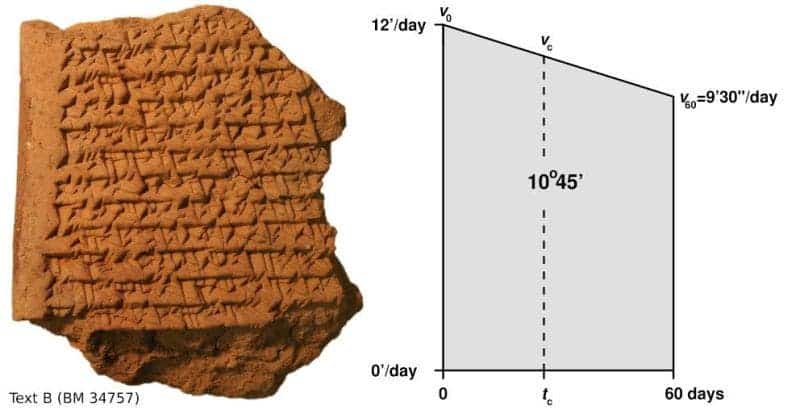A German astrophysicist decoded ancient Babylonian tablets stuffed with computations. His analysis reveals that these were used by the ancient scholars to predict where and when Jupiter would show up in the night’s sky based on abstract computations so advanced they’re indispensable to modern science. It’s thought analytical geometry was invented at Oxford in the 14th century, but it seems the Babylonians had it covered more than 1,400 years earlier.

Mathieu Ossendrijver of Humboldt University in Berlin is an astrophysicist, but also somewhat the expert in ancient history. For some time he had taken interest in four Babylonian tablets housed at the British Museum in London. These were curious because no one knew what they meant, apart from being calculations, but what were these scholars trying to compute?
Babylonians lived in what’s today Iraq and Syria. These lands were called Mesopotamia — a fertile plain between the Tigris and Euphrates rivers — where mathematics was used as early as 5,000 years ago. This was simple algebra, though, written in cuneiform in base60 to add, subtract and multiply. This was useful for keeping track of livestock and other household needs. In time mathematics evolved. Around 2,000 BC, the Babylonians, a Semitic people, invaded the area and established control, usurping the Sumerians. We don’t know if they picked up were the Sumerians and Akkadians left off with mathematics or brought their own expertise, but what’s clear is that they were very astute mathematicians.

They used an abstract form of writing based on cuneiform (i.e. wedge-shaped) symbols which they wrote on wet clay tablets. These were left to bake in the hot sun and many thousands of these tablets have survived to this day. Thanks to these we now know that the Babylonian excelled at algebra. They used tables of squares and cubes, had formulas for products and could solve quadratic equations.
From counting cattle, the Babylonians evolved to counting stars and studying their motion. These include Venus tablets of Ammizaduga (1,500 B.C.), eclipse records, new-moon records, and apparently the study of Jupiter.
Ossendrijver broke the code after one day someone from the British Museum sent him photographs of some of the stored Babylonian tablets. A rounded clay object proved to be a kind of Rosetta Stone. Text A, as it’s been dubbed, is itched in markings that served as a kind of abbreviation of a longer calculation which could be found in the four mysterious tablets. After careful scrutiny, Ossendrijver found that together these five tablets computed the predictable motion of Jupiter relative to the other planets and the distant stars.

What’s more, the Babylonians used what mathematicians today commonly call the trapezoid procedure — a cornerstone of calculus, first thought to be developed in medieval Oxford.
“This figure – a rectangle with a slanted top – describes how the velocity of a planet, which is Jupiter, changes with time,” he said for the BBC.
“We have a figure where one axis, the horizontal side, represents time, and the other axis, the vertical side, represents velocity.
“The area of trapezoid gives you the distance travelled by Jupiter along its orbit.
“What is so special is this type of graph is unknown from antiquity – so making figures of motion in this rather abstract space of velocity against time – this is something very, very new.”
Nobody knows yet if this was a favorite method among the astronomers or the work of some lone genius. There’s also no way of telling whether the Babylonians employed a heliocentric universe (Earth orbits the sun) or a Ptolemaic system like the Greek.
“Who knows what else is hidden in the thousands of tablets lying in in museums around the world?” Ossendrijver told Gizmodo. “This is part of the history of science, and I hope it raises awareness of the value of protecting that heritage.”
Journal Reference: Ancient Babylonian astronomers calculated Jupiter’s position from the area under a time-velocity graph






